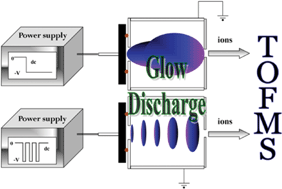Investigations have been carried out into coupling a microsecond pulsed direct current glow discharge to a time-of-flight mass analyser (μs-GD-TOFMS), aiming at studying the effects of the pulse parameters on mass spectra for analytical applications, including signal intensities, crater shapes and sputtering rates of conducting samples. By comparing the results obtained in four model materials (stainless steel, zinc, brass and an aluminium matrix) using pulsed and continuous dc voltages, a strong reduction (3–6 times, depending of the matrix) of the sputtering processes for the pulsed mode has been observed. This can be associated to the low average power available in each period. Conversely, the high voltage reached in a pulse seems to enhance ion generation, allowing for a notable sensitivity increase (about 50 fold) compared with dc continuous voltage operation. Concerning the effect of operating parameters typical of pulsed sources, the repeller delay has been demonstrated to be a critical parameter in achieving good analytical signals.

You have access to this article
 Please wait while we load your content...
Something went wrong. Try again?
Please wait while we load your content...
Something went wrong. Try again?


 Please wait while we load your content...
Please wait while we load your content...